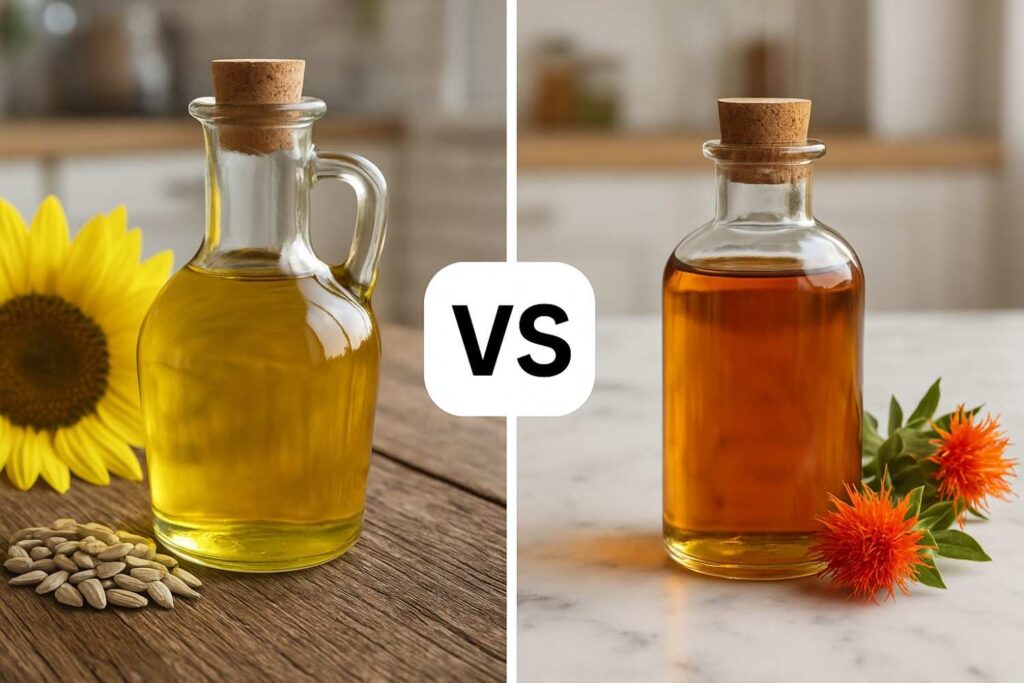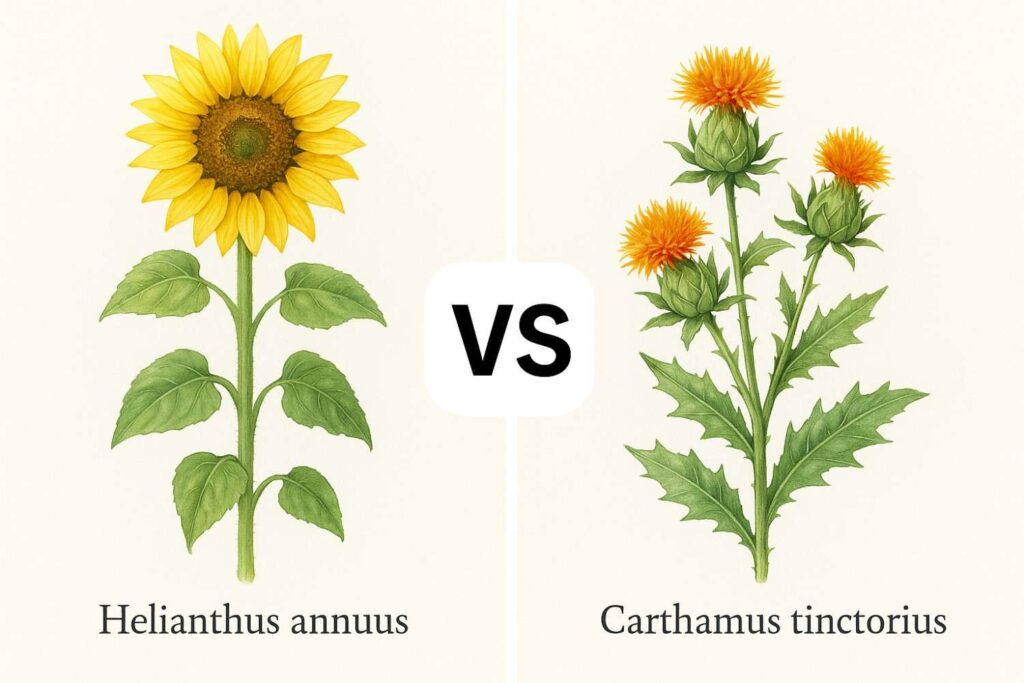
Remember that viral TikTok claiming seed oils are “toxic sludge”? I’ve watched clients panic-toss perfectly good oils—only to replace them with trendy alternatives that aren’t any healthier. Let’s cut through the noise.
Why This Matters to Your Health

Sunflower and safflower oils sit in nearly every American pantry, hiding in everything from salad dressings to granola bars. But confusion runs wild: Is sunflower oil bad for you? Does safflower oil cause inflammation? I’ve seen gluten-free folks stress over oils while overlooking bigger risks. Today, we’ll dissect myths, label tricks, and what actually impacts your health—backed by science, not social media hype.
Sunflower Oil vs Safflower Oil: Not the Same Thing!
Keywords addressed: is sunflower oil and safflower oil the same, what is the difference between sunflower oil and safflower oil
Let’s clear this up first: No, they’re not interchangeable.
- Sunflower oil comes from Helianthus annuus seeds (yes, those cheerful backyard flowers).
- Safflower oil is squeezed from Carthamus tinctorius, a thorny plant used historically as a dye.
My kitchen experiment: I once subbed safflower for sunflower oil in muffins. The safflower version tasted grassier and dried out faster—proof that chemistry matters.
The Quick-Reference Guide: Sunflower vs Safflower Oil
(Spoiler: The “high oleic” label changes everything)
| Feature | Sunflower Oil | Safflower Oil |
| Fat Profile | Varies wildly: Linoleic (65% PUFA) or High Oleic (80% MUFA) | Mostly linoleic (75% PUFA); High Oleic rare |
| Smoke Point | Refined: 450°F; Unrefined: 225°F | Refined: 510°F; Unrefined: 225°F |
| Best Uses | High-oleic: frying; Unrefined: dressings | Refined: high-heat frying; Unrefined: cosmetics |
| Vitamin E | 🌟 High (32% DV per tbsp) | 🌟 High (29% DV per tbsp) |
| Biggest Risk | Linoleic type oxidizes easily when heated | Highest omega-6 content of any oil |
The Processing Secret Labels Hide
Bottled Oil Isn’t “Natural”
Most supermarket oils undergo hexane extraction, a chemical process that strips nutrients. Cold-pressed oils retain more vitamin E and antioxidants but cost more. Personal tip: I reserve pricey cold-pressed safflower oil for skin serums—it’s stellar for DIY beauty blends.
Why “High Oleic” Is a Health Game-Changer
Traditional sunflower/safflower oils are loaded with linoleic acid (omega-6 PUFAs). Overconsumption spikes inflammation when omega-3 intake is low (a common U.S. issue). High oleic versions, bred for 80% monounsaturated fats, mimic olive oil’s benefits:
- ✅ 75% less oxidation during cooking (Journal of Food Science)
- ✅ Improves LDL cholesterol better than linoleic oils (American Heart Association)
Fun fact: I switched to high-oleic sunflower oil for stir-fries—no more acrid kitchen smoke.
Debunking 3 Major Health Myths
Myth 1: “All Seed Oils Cause Inflammation”
Truth: It’s about balance, not blanket bans. Americans get 10x more omega-6s than omega-3s. High-oleic oils reduce this imbalance; linoleic oils worsen it.
Myth 2: “Sunflower Oil Clogs Arteries”
Truth: High-oleic sunflower oil may lower heart disease risk by raising HDL cholesterol. The real villain? Reusing linoleic-rich oils for deep-frying, which creates toxic aldehydes.
Myth 3: “These Oils Make You Gain Weight”
Truth: All oils pack 120 calories/tbsp. But high-oleic types increase satiety hormones better than linoleic oils (Nutrition & Metabolism Study).
Gluten, Allergens, and Lecithin Explained
The Gluten-Free Reality
Pure sunflower/safflower oils contain no gluten. But cross-contamination risks exist in facilities processing wheat. For celiac safety:
- Choose refined oils (processing removes protein traces)
- Look for certified gluten-free labels (e.g., Spectrum Organics)
- Avoid bulk bins
Sunflower Lecithin ≠ Seed Oil
Lecithin is a fat emulsifier extracted during oil refining. It’s used in supplements (like these NOW capsules) and chocolate. Not an oil, but derived from it.
Beauty Uses: Surprising Skin & Hair Benefits

Why Sunflower Oil Is a Skin Superstar
With a comedogenic rating of 0-2, sunflower oil rarely clogs pores. Its linoleic acid repairs skin barriers—ideal for eczema. I mix it with shea butter for a non-greasy body cream.
Safflower Oil for Hair? Yes!
High in oleic acid, it penetrates hair shafts better than coconut oil. Try warm safflower oil as a pre-shampoo mask for shine.
The Ultimate Choice: Which Oil Wins Sunflower Oil or Safflower Oil?
| Your Goal | Best Pick | Avoid |
| High-heat frying | Refined high-oleic sunflower oil | Linoleic safflower oil |
| Heart health | High-oleic sunflower oil | Traditional “vegetable oil” blends |
| Gluten-free safety | Refined, certified GF oils | Bulk-bin oils |
| Acne-prone skin | Cold-pressed sunflower oil | Coconut oil |
FAQs: Your Top Questions Answered
Q: Is sunflower oil and safflower oil the same?
A: No—different plants, fatty acid profiles, and uses. Always check labels for “high oleic.”
Q: Is sunflower oil bad for you?
A: Not inherently. Linoleic versions should be limited; high-oleic is a heart-healthy choice.
Q: Is safflower oil better than sunflower oil?
A: For ultra-high-heat cooking, refined safflower wins. For daily health, high-oleic sunflower oil dominates.
Key Takeaways
- “High oleic” labels trump brand names for health benefits
- Never heat linoleic-rich oils (traditional sunflower/safflower) past 350°F
- Gluten risks come from processing—not the oils themselves
- Use cold-pressed oils raw; save refined oils for searing
Final Thought: After years of testing oils, I keep two in my kitchen: high-oleic sunflower oil for cooking, and a pricey cold-pressed safflower oil for dressings. It’s not about banning “seed oils”—it’s about strategic choices.
Your turn: Which oil survives your pantry purge? Share your oil experiments below! 👇
Before you go, if you’re curious about other cooking oils or want a full breakdown of what makes an oil healthy, check out our complete guide to edible oils.
